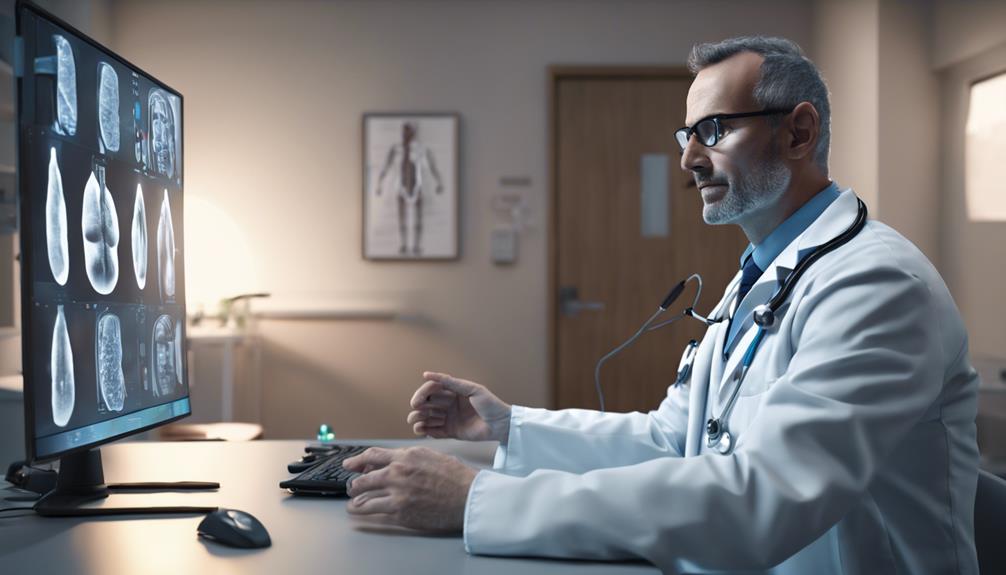Remote Work in Healthcare: Telemedicine's Role in Patient Care
In today's fast-paced healthcare landscape, the integration of telemedicine has revolutionized patient care delivery. Imagine a scenario where healthcare professionals can reach patients beyond physical boundaries, offer timely interventions, and improve health outcomes through virtual consultations and monitoring. But what challenges and opportunities does this shift towards remote work in healthcare present? How does telemedicine truly impact the patient-provider relationship and overall healthcare accessibility? The answers lie in exploring the multifaceted role of telemedicine in shaping the future of patient care.
Key Takeaways
- Telemedicine enables remote patient care through virtual consultations.
- Access to healthcare services from home enhances patient convenience.
- Remote work in healthcare supports efficient monitoring and diagnostics.
- Virtual communication tools enhance patient-provider interactions.
- Telemedicine bridges gaps in healthcare access, especially in rural areas.
Telemedicine's Growth in Healthcare
The growth of telemedicine in healthcare has revolutionized the way patient care is delivered, offering unprecedented convenience and access to medical services. Telemedicine regulation plays a vital role in shaping the landscape of telehealth adoption trends.
As regulations evolve to accommodate the increasing demand for remote healthcare services, providers are more inclined to integrate telemedicine into their practices. Telemedicine regulation encompasses a wide range of aspects, including licensure requirements for healthcare professionals practicing across state lines, reimbursement policies for virtual consultations, and privacy and security standards for telehealth platforms. These regulations aim to safeguard patient safety, quality of care, and data protection in telemedicine interactions.
Telehealth adoption trends reflect the shifting preferences of both patients and healthcare providers towards remote consultations. Factors such as improved technology infrastructure, greater acceptance of virtual care among patients, and the convenience of telemedicine appointments contribute to the upward trajectory of telehealth adoption.
Understanding and complying with telemedicine regulations are essential for healthcare organizations looking to successfully navigate the expanding world of remote patient care.
Benefits of Remote Consultations
With the advancement of telemedicine technology, remote consultations offer healthcare providers and patients a multitude of benefits regarding accessibility and efficiency.
Remote therapy sessions conducted through telemedicine platforms allow patients to receive mental health services from the comfort of their own homes. Online counseling services have become increasingly popular, providing individuals with convenient access to licensed therapists through video calls or messaging apps.
These remote consultations eliminate the need for travel and waiting rooms, saving time and reducing stress for patients. Additionally, healthcare providers can efficiently connect with a broader range of patients, including those in remote or underserved areas.
The flexibility of scheduling remote consultations allows for better integration of mental health care into patients' daily lives, promoting regular therapy sessions and improving overall mental well-being.
Virtual Monitoring Technologies
You can enhance patient care by leveraging virtual monitoring technologies. These include remote essential sign monitoring, real-time health data analysis, and patient self-tracking devices. These tools allow healthcare providers to track patients' health status continuously, enabling early detection of any concerning trends or abnormalities.
Remote Vital Sign Monitoring
Utilizing virtual monitoring technologies enables real-time tracking of essential signs remotely, revolutionizing the way healthcare providers can monitor and manage patient health outside of traditional clinical settings.
Remote essential sign monitoring plays an important role in remote wellness programs and can lead to improved patient outcomes. Wearable technology and remote patient monitoring technologies have become instrumental in this process, allowing for continuous monitoring of key essential signs such as heart rate, blood pressure, oxygen saturation levels, and more from the comfort of a patient's home.
These technologies not only enhance patient care but also facilitate telehealth reimbursements by providing healthcare professionals with accurate and timely data to support their assessments and interventions.
Remote essential sign monitoring systems offer both patients and providers a convenient and efficient way to stay connected and monitor health conditions proactively. By leveraging these advancements, healthcare organizations can offer more personalized care, detect early warning signs, and intervene promptly, ultimately improving patient satisfaction and overall health outcomes.
Real-Time Health Data
Real-time health data plays a pivotal role in modern healthcare through the integration of virtual monitoring technologies, allowing for continuous and remote tracking of vital signs and health metrics. Wearable devices are at the forefront of this revolution, enabling real-time monitoring of a patient's heart rate, blood pressure, oxygen levels, and more. These devices transmit data wirelessly to healthcare providers, giving them immediate access to important information without the need for in-person visits.
Virtual monitoring technologies offer a complete view of a patient's health status, facilitating early detection of potential issues and proactive interventions. By analyzing real-time health data, healthcare professionals can identify trends, personalize treatment plans, and make informed decisions promptly. This proactive approach can lead to improved patient outcomes, reduced hospitalizations, and better management of chronic conditions.
In essence, real-time health data obtained through wearable devices and virtual monitoring technologies is revolutionizing patient care, enabling healthcare providers to deliver more personalized and efficient services while empowering individuals to take an active role in monitoring their health.
Patient Self-Tracking Devices
Patient self-tracking devices, also known as virtual monitoring technologies, play a critical role in modern healthcare by enabling individuals to monitor their health metrics remotely. Wearable technology, such as smartwatches and fitness trackers, are popular examples of these devices. These wearables can track essential signs like heart rate, activity levels, and even sleep patterns, providing users with real-time data about their health status.
Health tracking apps complement these wearables by aggregating and analyzing the information collected, offering insights and trends that can help individuals make informed decisions about their well-being.
Enhancing Patient-Provider Communication
Enhancing communication between healthcare providers and individuals seeking medical assistance is essential for ensuring effective telemedicine services. Patient empowerment plays a pivotal role in this process, allowing patients to actively participate in their healthcare decisions.
Implementing digital communication strategies can greatly enhance patient-provider interactions in telemedicine. Digital communication strategies encompass various tools such as secure messaging platforms, video conferencing, and patient portals. These tools enable real-time communication between patients and healthcare providers, fostering a sense of connection and improving the overall telemedicine experience.
Patients can easily discuss their symptoms, concerns, and treatment plans with providers remotely, leading to more personalized care and better health outcomes. Furthermore, these digital tools allow for the seamless sharing of medical records, test results, and treatment recommendations, creating a collaborative environment between patients and providers.
Remote Diagnostics and Testing
You can explore how virtual imaging technologies enable healthcare providers to conduct remote diagnostics with precision and efficiency.
Additionally, remote lab sample collection methods offer a convenient way to gather necessary patient data without the need for in-person visits.
These advancements in remote diagnostics and testing play an essential role in enhancing patient care and streamlining healthcare processes.
Virtual Imaging Technologies
Utilizing virtual imaging technologies in healthcare enables healthcare providers to remotely conduct diagnostics and testing, revolutionizing the way patient care is delivered.
Through virtual consultations and remote imaging, telemedicine advancements have greatly enhanced the efficiency and accuracy of diagnosing and monitoring patients. Telehealth technology allows medical professionals to remotely access high-quality imaging scans, such as X-rays, MRIs, and CT scans, enabling timely and precise evaluations without the need for in-person visits.
Virtual imaging technologies play an important role in facilitating remote diagnostics by providing healthcare providers with detailed insights into a patient's condition. These technologies allow for real-time collaboration between specialists, enabling quick decision-making and streamlined treatment planning.
Additionally, the ability to securely share imaging data across different healthcare facilities enhances care coordination and ensures that patients receive the most appropriate and timely interventions.
Remote Lab Sample Collection
Remote lab sample collection in healthcare involves the process of obtaining biological specimens from patients in a non-invasive manner for diagnostic testing purposes. Remote specimen collection offers significant advantages for both patients and healthcare providers.
For patients, the convenience of providing samples from their own homes eliminates the need for travel and reduces potential exposure to illnesses present in healthcare facilities. This process also allows for more flexibility in scheduling appointments, making healthcare more accessible.
Healthcare providers benefit from virtual lab samples by streamlining the testing process, leading to increased efficiency in diagnosing and treating patients. By collecting samples remotely, healthcare professionals can focus on analyzing results and providing appropriate care rather than spending time on sample collection. Additionally, remote specimen collection can enhance patient monitoring, especially for individuals with chronic conditions who require regular testing.
Prescription Management in Telemedicine
When prescribing medications through telemedicine, healthcare providers must ensure the accuracy and safety of the prescription process. Medication adherence plays a vital role in ensuring positive patient outcomes.
Virtual consultations enable healthcare professionals to discuss medication regimens, potential side effects, and the importance of following the prescribed treatment plan.
Remote prescription services offered through telehealth platforms facilitate the seamless transfer of prescriptions to pharmacies for fulfillment. These platforms not only enhance convenience for patients but also streamline the prescription management process for healthcare providers.
By leveraging telemedicine technologies, healthcare professionals can electronically send prescriptions to pharmacies, reducing the likelihood of errors associated with traditional paper prescriptions.
Furthermore, telemedicine allows for efficient medication management, enabling healthcare providers to monitor patients' adherence to prescribed medications remotely. Through virtual follow-ups and consultations, healthcare professionals can address any issues related to medication adherence promptly, ultimately improving patient care and treatment outcomes.
Telemedicine's Impact on Accessibility
Telemedicine's enhancement of healthcare accessibility has revolutionized patient care delivery by overcoming geographical barriers and increasing the reach of medical services. In rural communities, where access to healthcare facilities is limited, telemedicine plays an essential role in providing essential medical consultations. Patients residing in remote areas can now connect with healthcare professionals through virtual appointments, ensuring timely diagnosis and treatment.
Moreover, telemedicine has greatly improved access to mental health services through remote consultations. Individuals seeking mental health support no longer face the challenge of long travel distances or limited availability of specialists. With telemedicine, patients can engage in therapy sessions, receive counseling, and access psychiatric evaluations from the comfort of their homes.
This convenience not only enhances accessibility but also reduces the stigma associated with seeking mental health treatment.
Ensuring Data Security and Compliance
To maintain confidentiality and comply with regulatory standards, healthcare providers must implement robust data security measures when utilizing telemedicine for patient care. Data encryption plays an important role in safeguarding sensitive patient information transmitted during remote consultations. By encrypting data, healthcare organizations can protect it from unauthorized access, ensuring patient privacy is upheld.
Regulatory compliance is another key aspect that healthcare providers must prioritize when offering telemedicine services. Adhering to regulations such as HIPAA (Health Insurance Portability and Accountability Act) is essential to avoid potential legal implications and maintain trust with patients. Implementing stringent security protocols and ensuring that all telemedicine platforms meet regulatory requirements are fundamental steps in achieving compliance.
Furthermore, healthcare providers should regularly review and update their security measures to address evolving threats and compliance standards. Conducting regular risk assessments and staying informed about any changes in regulations are important to maintaining a secure telemedicine environment for both providers and patients.
Future Trends in Telemedicine
The landscape of telemedicine is continuously evolving, with emerging trends shaping the future of remote healthcare delivery. In the domain of telemedicine regulations and policy, there's a growing focus on standardizing practices across different states to guarantee consistency in care quality and patient protection. Policymakers are working to establish guidelines that address licensure requirements for healthcare providers practicing telemedicine across state lines, aiming to enhance access to care while maintaining regulatory oversight.
Regarding telehealth reimbursement models, there's a shift towards greater acceptance and integration of telemedicine services into traditional payment structures. Payers are increasingly recognizing the value of telehealth in improving healthcare access and outcomes, leading to the development of more inclusive reimbursement policies.
As telemedicine continues to gain prominence, it's anticipated that reimbursement models will evolve to incentivize healthcare organizations and providers to adopt telehealth solutions, thereby expanding the reach of remote care services to more patients.
Conclusion
As you navigate the ever-evolving landscape of healthcare, remember that telemedicine is your gateway to a world of accessible, efficient, and engaging patient care.
Embrace the power of remote consultations, virtual monitoring technologies, and seamless communication tools to revolutionize the way you deliver healthcare.
Picture a future where quality care is just a click away, where timely interventions and improved outcomes are the norm.
Embrace telemedicine, and watch as the healthcare landscape transforms before your eyes.







